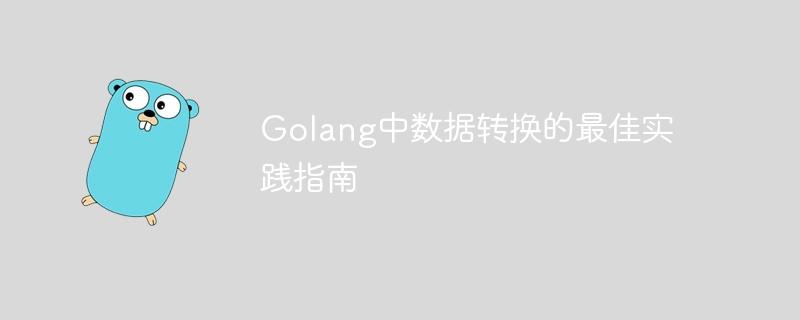Home >Backend Development >Golang >Best practice guide to data transformation in Golang
Best practice guide to data transformation in Golang
- WBOYWBOYWBOYWBOYWBOYWBOYWBOYWBOYWBOYWBOYWBOYWBOYWBOriginal
- 2023-12-23 13:07:52594browse

Best Practice Guide for Data Transformation in Golang
Introduction:
In Golang, data transformation is a common requirement. Whether you are converting from user input to a specific type, or from one data structure to another, you need to use appropriate methods for data conversion. This article will introduce some best practices for data conversion in Golang and provide specific code examples.
1. Convert strings to integers
In Golang, converting strings to integers is a common requirement. This can be achieved using the Atoi function in the built-in strconv package.
Sample code:
package main
import (
"fmt"
"strconv"
)
func main() {
str := "12345"
num, err := strconv.Atoi(str)
if err != nil {
fmt.Println("Conversion error:", err)
return
}
fmt.Println(num)
}The above code converts the string "12345" to an integer and prints the result 12345.
2. Convert integers to strings
Similarly, converting integers to strings is also a common requirement. This can be achieved using the Itoa function in the strconv package.
Sample code:
package main
import (
"fmt"
"strconv"
)
func main() {
num := 12345
str := strconv.Itoa(num)
fmt.Println(str)
}The above code converts the integer 12345 to a string and prints the result "12345".
3. Convert a string to a Boolean value
Sometimes you need to convert a string into a Boolean value. You can use the ParseBool function in the strconv package to achieve this.
Sample code:
package main
import (
"fmt"
"strconv"
)
func main() {
str := "true"
b, err := strconv.ParseBool(str)
if err != nil {
fmt.Println("Conversion error:", err)
return
}
fmt.Println(b)
}The above code converts the string "true" to the Boolean value true and prints the result.
4. Date and time type conversion
When processing date and time types, you can use the functions provided by the time package for conversion.
Sample code:
package main
import (
"fmt"
"time"
)
func main() {
str := "2022-01-01"
layout := "2006-01-02"
date, err := time.Parse(layout, str)
if err != nil {
fmt.Println("Conversion error:", err)
return
}
fmt.Println(date)
}The above code converts the string "2022-01-01" to the time.Time type and prints the result.
5. Conversion between structures
In Golang, it is often necessary to convert one data structure into another. At this time, you can use the following method to convert.
Sample code:
package main
import (
"fmt"
)
type Person struct {
Name string
Age int
}
type Employee struct {
FirstName string
LastName string
}
func main() {
p := Person{
Name: "John",
Age: 30,
}
e := Employee{
FirstName: p.Name,
LastName: "Doe",
}
fmt.Println(e)
}The above code converts a Person structure into an Employee structure and prints the result.
6. Conversion between slices and arrays
In Golang, slices and arrays are commonly used data structures. Conversions can be done using index assignment between slices and arrays.
Sample code:
package main
import (
"fmt"
)
func main() {
arr := [5]int{1, 2, 3, 4, 5}
slice := arr[2:4]
fmt.Println(slice)
}The above code converts the elements at index 2 to 4 of the array arr into slices and prints the result.
Conclusion:
Whether it is conversion between strings and integers, or conversion between time types and structures, Golang provides a wealth of functions and methods to achieve data conversion. When performing data conversion, attention should be paid to error handling to avoid abnormal situations. Through the above best practices, I believe readers have understood the basic methods of data conversion in Golang and can use them flexibly according to actual needs.
The above is the detailed content of Best practice guide to data transformation in Golang. For more information, please follow other related articles on the PHP Chinese website!

